Gemstones in Vietnam
A review
Pham Van Long1, Gaston Giuliani2, Virginie Garnier3, Daniel Ohnenstetter3
1 Center for Gem and Gold Research and Identification, Hanoi, Vietnam
2 IRD and CRPG/CNRS, BP 20, 54501 Vandœuvre, France
3 CRPG/CNRS, UPR 2300, BP 20, 54501 Vandœuvre, France
 |
Note: We are pleased to reproduce the following article by kind permission of Dr. Grahame Brown, Editor of The Australian Gemmologist. Reprinted from The Australian Gemmologist |
Abstract
Vietnamese research in geology has indicated a high potential for gemstones in Vietnam and has found in this last decade numerous gem deposits, especially ruby and sapphire. In northern Vietnam, gem corundums are found in the Luc Yen, Yen Bai and Quy Chau areas, in primary deposits hosted by metamorphic rocks and in placers. In secondary deposits, ruby and sapphire are associated with gem spinel and garnet. In southern Vietnam, sapphires are related to alkaline basalts, with blue sapphires being economic. Sapphires are recovered with gem zircons and peridots in placers. Aquamarine, beryl, topaz, quartz crystals (amethyst, citrine, morion), tektite, fluorite, opal, chalcedony, jadeite, nephrite and amazonite are the other gemstones exploited in Vietnam. Ruby, sapphires and pearls provide important commercial exchanges in the gemstones markets of Vietnam and other foreign countries.
Introduction
In the late 1980s, reports emerge from Vietnam of a major discovery of high quality rubies in the northern part of the country, from deposits in the Luc Yen and Yen Bai areas. Ruby occurred in colluvial and alluvial sediments, and the primary source of ruby was suspected to be marble and pegmatite. Placer deposits of ruby were recovered by farmers during routine agricultural activities. Following the discovery of ruby in Luc Yen in 1987, others occurrences of gemstones were found in Thuong Xuan (aquamarine and topaz), Co Phuong (jadeite, nephrite), Thach Khoan (beryl, quartz), Quy Chau (ruby) and in the Dak Lak and Binh Thuan provinces (sapphire). After these discoveries, gemstone exploitation really started in 1988 with the establishment of Vinagemco by the government—a state-owned company for the investigation, mining, processing, and trading of gem materials in Vietnam (Fig. 1). The purpose of this paper is to realize an overview of the gemstones occurrences in Vietnam with a special dedication to ruby and sapphire.
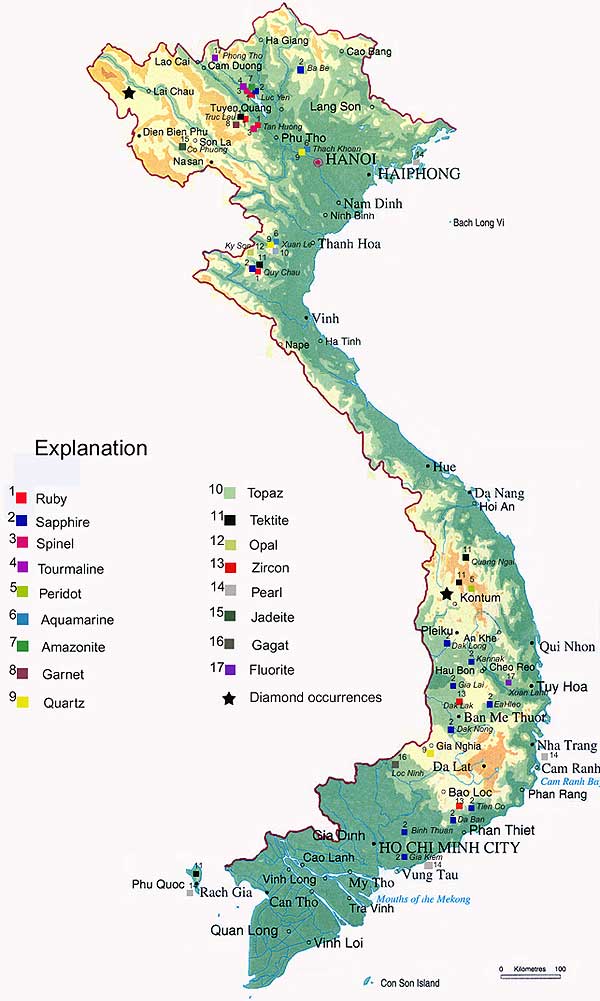 |
| Figure 1. Map of Vietnam showing the location of gemstone occurrences. |
Distribution of gemstones
Ruby and sapphire deposits
In northern Vietnam
Yen Bai mining district
The primary corundum occurrences of Yen Bai (Fig. 2) occur within the high-grade metamorphic gneisses of the Day Nui Con Voi range (Pham Van 1996, 2003), which extends to the southeast from the Ailao Shan in Yunnan (China). This range is bounded by lateral strike-slip faults forming the major Cenozoic geological discontinuity in East Asia known as the Ailao Shan-Red River shear zone (Phan Trong et al. 1998, 1999, Leloup et al. 2001). The Day Nui Con Voi range is composed of high-grade metamorphic rocks with sillimanite-biotite-garnet gneisses, mica-schists with local alternation of marbles and amphibolites.
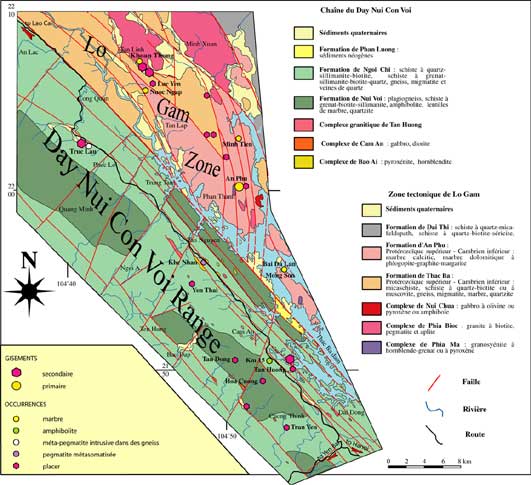 |
| Figure 2. Geological map of Yen Bai area with locations of ruby and sapphire deposits. |
Corundum occurs as:
- grey to blue sapphires in garnet-sillimanite mica schists and gneisses which contain leucosome and leucocratic granitoidic dykes (Truc Lau gneisses and Khe Nhan meta-pegmatite);
- in amphibolites converted by the effect of metasomatism in biotite schists with some layers containing centimetre-sized grey to dark sapphires (north of Tan Huong mine, km 15 occurrence;
- as rubies in large marble boudins intercalated with gneiss, mica schist and amphibolite (Tan Huong drill cores). These marbles represent previous limestones intergrown with mudstones, which were sheared and metamorphosed during the tectonic activity along the Red River shear zone.
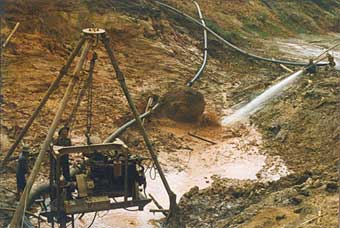 |
| Figure 3. Exploitation of ruby in Tan Huong mine. |
The gem deposits are placers exploited along the shear zone as in Tan Huong and Truc Lau (Fig. 2). In Tan Huong, ruby was found and exploited by local farmers in 1994. In 1996, the deposit was managed and exploited by the Vietnam National Gem and Gold Corporation (Fig. 3). From 1994 to 1996, hundreds kilograms of rubies and star rubies were exploited illegally and sold to foreign dealers. The area is composed of metamorphic gneiss, micaceous-quartz schist, marble and amphibolite of the Nui Voi complex that have been intruded by granites, syenites and pegmatite dykes. Ruby and spinel have been found in the magmatic rocks in minor grains as well as in marbles (Nguyen Kinh Quoc et al. 1995). In placers, ruby grains are eroded but the crystals present a prismatic shape, are from 1.0 to 19 mm long, and range in colour from red to reddish and purplish to red. The main associated gem mineral are red and octahedral spinels and blue trapiche-like sapphires. In April 1997, two ruby crystals of 2.58 kg (Fig. 4) and 1.96 kg (star ruby) respectively, of very high quality, were found and declared State treasure.
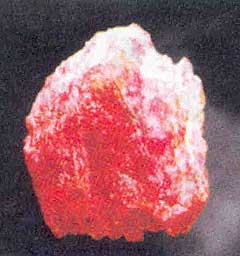 |
| Figure 4. The ruby called Star of Vietnam weighing 2.58 kg that was found in the Tan Huong mine. |
The Truc Lau paleoplacer consists of 10 m thick of sediments overlying the bedrock. The rubies and blue sapphires are contained in a gravel layer of 5 m thickness that is overlain by a 3.5 m of quaternary sediments and 1-1.5 m of soil. In 2002, up to two boulders (1-2 kg) per month made of pink sapphire and star ruby were recovered from this paleoplacer.
In the Tan Dong placer (Fig. 2), assemblages of blue sapphire-margarite-plagioclase are the remainder of metasomatised pegmatites.
Luc Yen mining district
The ruby and sapphire deposits of Luc Yen (Fig, 2) are set in moderate to high temperature recrystallized marble units of Upper Proterozoic-Lower Cambrian age in the eastern side of the Red River shear zone of the Lo Gam tectonic zone (Hoang Quang et al. 1999, Garnier, 2003, Pham Van 2003).
Primary ruby occurs as:
- disseminated crystals within marbles with phlogopite, dravite, margarite, pyrite, rutile, spinel, edenite and graphite (Bai Da Lan, An Phu, Minh Tien, Nuoc Ngap, Luc Yen and Khoan Thong mines);
- veinlets associated with calcite, dravite, pyrite, margarite and phlogopite (An Phu mine);
- fissures with graphite, pyrite, phlogopite and margarite (Bai Da Lan mine); Minh Tien region (Fig. 5).
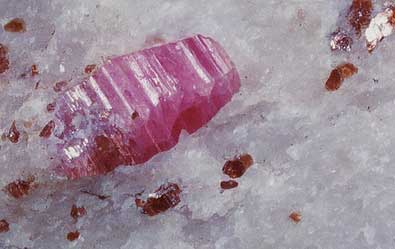 |
| Figure 5. Flakes of phlogopite (brown) associated with a 1.5 cm long ruby crystal from Minh Tien area. |
Secondary deposits consist of gravel concentration in karst pockets and in alluvial fans in the Luc Yen valleys (Kane et al.. 1991). The gem-bearing valleys are often narrow, small depressions ranging from 0.5 to 0.7 km2 in area, but most common 2-3 km2. The corundums are pink, purple to red (Fig. 6), and blue and colourless sapphires coexist with rubies as well as with grey to brown and bi-pyramidal sapphires and trapiche rubies. Associated gem minerals include red, pink and pale blue spinel, gem quality multi-colour tourmaline and garnet. The great variety and high quality of the gem material recovered in the placers make the gemstone market in the center of Luc Yen town opened daily for dealers since 1987 (Fig. 7).
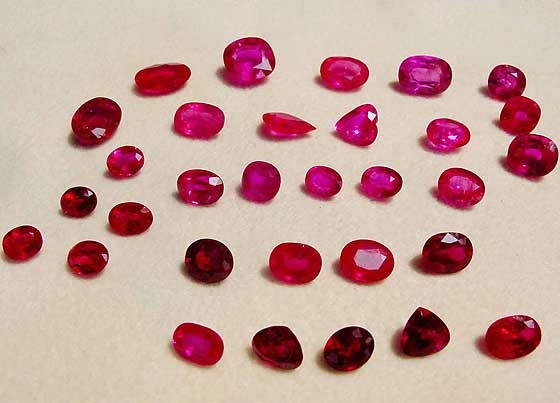 |
| Figure 6. Gem-quality rubies and pink sapphires from Luc Yen deposits. |
Ba Be sapphire occurrence
This is located in the Bac Kan province, 320 km north of Hanoi (Fig. 2). It is located at the proximity of the Nui Chua granite and the Hoang Tri gabbro-monzonite. The colourless to pale blue sapphire is found in a pegmatite, composed of quartz, K-feldspar and muscovite, which intrudes schist and marble. All sapphires are opaque and cannot be used for gem cutting.
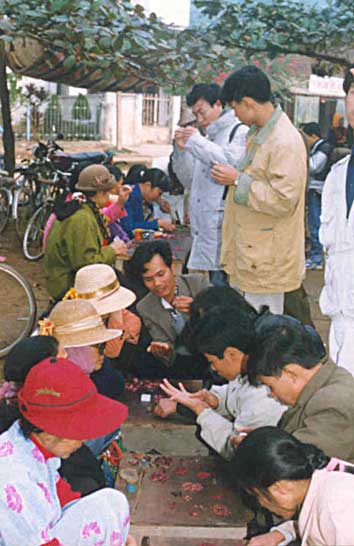 |
| Figure 7. The Luc Yen gemstones market. |
Quy Chau mining district
This area, located 200 km south of the Red River shear zone, is formed by the Bu Khang dome (Fig. 1). It consists in a broad antiform of Paleozoic and Mesozoic sedimentary and meta-sedimentary rocks overlaying a core of micaschists, granitoids, paragneisses and orthogneisses (Nguyen Kinh Quoc et al. 1995; Jolivet et al. 1999). The northeastern part of the dome is limited by the major extensional Cenozoic shear zone of Quy Chau. This is where the corundum deposits are located.
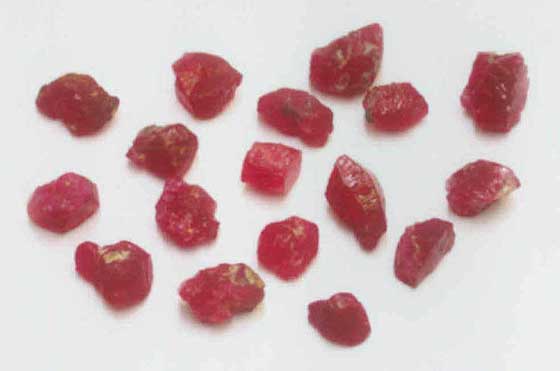 |
| Figure 8. Rough ruby from Quy Chau deposit. |
Rubies and sapphires have been mined since 1987 from the placer deposits of Doi Ty, Doi San, Mo Coi and Quy Hop (Pham Van, 2003). The corundum occurs principally in the Quy Chau area as:
- very rare and uneconomic rubies disseminated in marbles associated with pyrite and graphite;
- in placers which form the economic deposit. In the Doi San and Doi Ty area, granitic intrusions resulted in the injection of pegmatites and the formation of calcium-magnesium-rich skarns in the surrounding marbles, amphibolites, gneiss and micaschists. Rubies were neither observed in the skarn nor in the pegmatite. The genetic origin of this ruby has remained unclear since oxygen isotopes and fluid inclusions studies on these rubies show that they their isotopic signature was metamorphic and similar to that found for typical ruby-hosted marble deposits in northern Vietnam (Garnier, 2003; Giuliani et al., 2003a, b). The gem material consists of ruby, with smaller amount of blue to violet and orange sapphire. Ruby tends to be slightly purplish red in hue position; their crystals are usually in hexagonal prism and barrel shape (Fig. 8).
In Southern Vietnam
The sapphire deposits of southern Vietnam consist of placers formed by the erosion of alkali-basalt flows (Smith et al. 1995). The sapphires present usually prismatic and pyramidal shapes. The size of the crystals is up to 2-7 mm long, but in Dak Nong, Ngoc Yeu and Da Ban areas they sometimes reach 30-40 mm in diameter. Their colour is usually dark blue, sometimes green blue, sky blue, and rarely honey-yellow (except in the Tien Co area in Binh Thuan province).
Several mining district were exploited from 1985 to present. These include:
The Dak Nong area (Dak Lak province)
Here the sapphires are found in weathered residual soils lying above the flows and also in the river and stream fans (Tran Xuan Toan et al. 1995). Generally, the alluvial corundum corresponds to xenocrysts found in situ in basalts (Hoang Nguyen & Flower 1998). The colour of the sapphires ranges from dark blue, through blue, green to yellow. The crystals occur as broken fragments, but with prismatic and bipyramidal shapes and dimensions of up to 1.5 cm long and 0.2-0.4 cm wide.
The Ma Lam and Da Ban area (Binh Thuan province)
The sapphires of these areas show barrel-shaped habits. The stones range from very dark blue to very deep blue. The alluvial corundum sometimes shows glassy-looking margins that indicate high temperature corrosion—indirect evidence of magma transport. In the Da Ban area megacrysts of dark-blue sapphires are sometimes found within alkali-basalts.
Diamond occurrences
Although diamonds are not yet discovered in the country, geological investigations in the north-western part of Vietnam and the Tay Nguyen Highland (Fig. 1) provides promising areas for primary diamond discovery. Recently, the occurrences of lamproïtes (alkali lamprophyres) were reported in the Lai Chau province in the north-western part of Vietnam. In Tay Nguyen (Kon Tum province), kimberlite dykes are discovered and the rocks are made of olivine, phlogopite, garnet, pyrope and perovskite. In the year 2000, small grains of diamonds (smaller than 2 mm in diameter) were recovered from placers in Tay Nguyen (Pham Binh, 2000). More detailed studies and investigation are still needed to prove the occurrences of diamond in Vietnam.
Emerald occurrences
Up to now, emerald and chrysoberyl have not yet been discovered in Vietnam, but the geological formations and structures in Ba Be (Bac Kan province) and Mo Ngot (Vinh Phu province) represent potential areas for emerald and chrysoberyl (Nguyen Kinh Quoc, 1995).
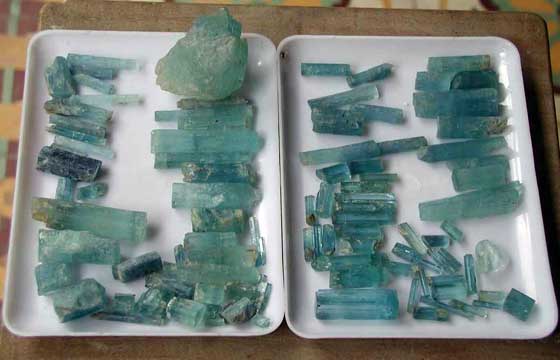 |
| Figure 9. Rough aquamarine from Thach Khoan deposit. |
Beryl (var. aquamarine) and topaz occurrences
Xuan Le (Thanh Hoa province)
The first discovery of aquamarine and topaz in Xuan Le area was made in 1985 by a field geologist. Aquamarine is hosted in a swarm of pegmatites, hundreds of metres long and 0.4-5.0 m thick, which contained quartz, K-feldspar, plagioclase, muscovite, biotite and accessory minerals as black tourmaline, colorless topaz, and zircon. The pegmatites are related to the intrusion of syeno-granite and biotite granite. Aquamarine of high gem quality has a hexagonal prismatic shape, is sea blue-coloured, transparent and with the size of the crystals from 5 to 20 cm long, 1 to 6 cm in diameter. These are exploited in elluvial deposits by local farmers.
Topaz in Xuan Le is related to pegmatites with a reserve potential about 41.53 tons (Nguyen Kinh Quoc 1995). The topaz is exploited, mainly in placers, which yield high gem quality material suitable for jewellery. Topaz crystals are usually broken by the alluvial transport, but they have colourless or yellowish colors and high transparency. Accessory minerals are beryl, tourmaline, fluorite, quartz (including smoked quartz) and garnet.
After 1985, numerous occurrences of topaz were found in the Bao Loc and Tu Le areas in the Lam Dong and Yen Bai provinces, respectively.
Thach Khoan (Vinh Phuc province)
Good gem quality beryls are exploited in Thach Khoan. The crystals are transparent to translucent, 3-4 cm in diameter, sometimes 10-30 cm long, and have a sky-blue colour (Fig. 9). In 1999, a crystal of beryl that weighed 75 kilograms, was displayed in the Geological Museum of Vietnam. Accessory minerals are quartz, black tourmaline, feldspar, garnet and kyanite.
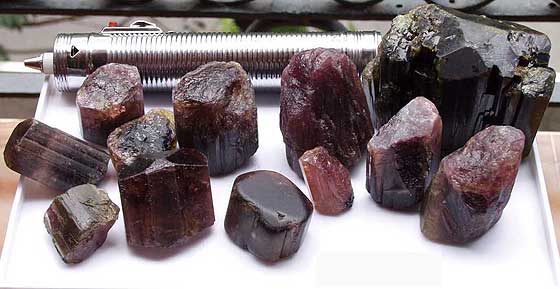 |
| Figure 10. Rough tourmaline from the Luc Yen deposits. |
Tourmaline
Tourmaline-bearing pegmatite has been reported in the region of Luc Yen (Nguyen Kinh Quoc 1995), but up to now gem quality tourmalines have not been found in situ. They occurred in alluvial gravels associated with gem-corundum or in a weathered crust. The crystals have striated prisms with rounded triangular cross-sections and are variously terminated. The Luc Yen tourmaline has variable colours ranging from green, brown, black to yellow (Fig. 10). Multicolor crystals, usually include alternating pink, purple and yellowish-green colour. Colour zoning is also commonly observed from the centre to the periphery of the crystals, with the combination of pink, purple and dark-green colours being common.
Spinel
Gem spinels were discovered at Tan Huong, Luc Yen and Quy Chau in primary and secondary ruby and sapphire deposits. In Luc Yen mining district, and in Tan Huong mine, spinel crystals are found in dolomitic marbles together with calcite-phlogopite-humite of metamorphic-metasomatic origin. The crystals vary in size from 1 x 1 cm to 3 x 3 cm. They have octahedral form and red to brownish red colour. Crystals of spinel that are recovered from placers are transparent and used for gem cutting, while bigger crystals in their host-rock are usually translucent to opaque and used only as collector’s specimens.
Zircon
Zircon and basaltic sapphires are usually found together in placers from Kon Tum, Dak Lak, Gia Lai, Lam Dong and Binh Thuan provinces. Their colour ranges from colorless to yellow, orange, brownish-orange, brownish to reddish-brown. The habit crystals are combinations of the bi-pyramid and the tetragonal prism. Crystals are usually corroded.
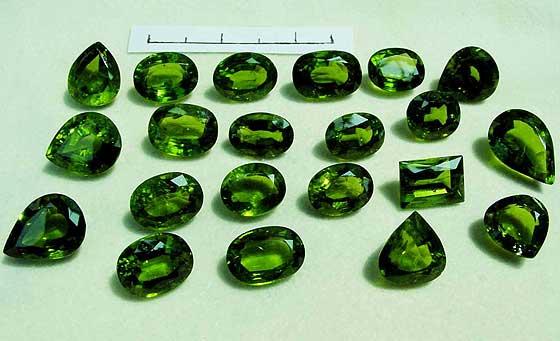 |
| Figure 11. Cut peridot from the Tay Nguyen highland of Vietnam that range in size from 2.35 to 8.42 ct. |
Peridot
Peridot is found mainly in the Ham Rong and Bien Ho basaltic areas of the Gia Lai province (Fig. 1). Peridots are collected from lherzolite xenoliths within the basalt flows. Gem peridot is olive-green to yellowish-green (Fig. 11) with crystals reaching up to 2 x 4 x 4 cm. However, most of peridot occurs in small grains that average 0.6 to 1.5 cm in diameter. Today, peridot is exploited in eluvial and stream gravels by local residents. In some places, the peridot-bearing layers are reached by hand digging 5 m-deep pits.
Tektites
Tektites have been found in many places, from the north to the south of Vietnam. Essentially they are recovered from the highlands of the Tay Nguyen province (Kon Tum and Lam Dong) and the Phu Quoc island. Some occurrences are located near the border between Vietnam and Laos. Almost all of the tewktites are cut as cabochons, or carved into cameos.
Pearl
Today, pearls are cultivated mainly at Cat Ba, Ha Long (Quang Ninh province), Nha Trang (Khanh Hoa province), Con Dao (Vung Tau province) and Phu Quoc (Kien Giang province) (Fig. 1). The pearl farms have been developed with the training and the supervision of Japanese experts. Today, the farms operate with only Vietnamese technicians. Four farms. Which are located at Cat Ba and Ha Long, belong to the Ha Noi Gem and Gold Corporation. Two farms in Nha Trang, and about six farms in Phu Quoc are joint-stock companies with a Japanese partners. Trial harvests have produced pearls with thicker nacre and better lustre than that presently available from both Japanese and Chinese akoyas. From 2001, Vietnamese akoyas will be cultured from spat-reared stock, with an expected yield of 1000 kan (1 kan = 3.745 kg) by the year 2008. Vietnamese akoyas (Fig. 12) range in size from 2 to 8 mm, and are produced in natural golden colour due to the good water quality and protected environment in which the pearls are cultivated Black South Sea pearls are now being cultured in Phuc Quoc. These vary in size from 4 to 8 mm. In Vietnam, 80 per cent of the annual cultured pearl production is exported, with 20 per cent remaining for the domestic markets.
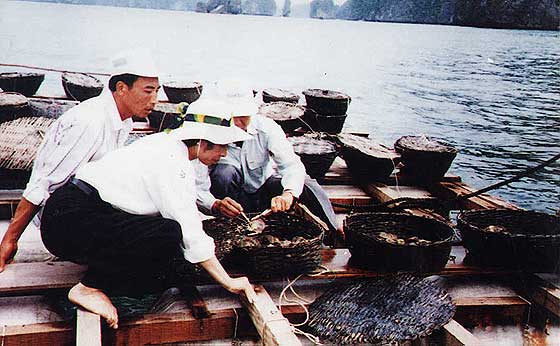 |
| Figure 12. Removing oysters from their cages and preparing for the operation of nucleus insertion at Ha Long Bay, northern Vietnam. |
Other gemstones
Quartz is one of the most abundant and widely distributed minerals in Vietnam. Varieties include rock crystal, amethyst, and rose quartz. Rock crystals and smoky quartz are found in pegmatite at Xuan Le (Thanh Hoa), Ky Son (Nghe An), Thach Khoan (Vinh Phu). Amethyst with an attractive purple colour, and high transparency, is found in Don Duong (Lang Son province) and Chu Boc (Gia Lai province) . Rose quartz has been found in Da Nang, morion in Loc Tan (Lam Dong).
Jadeite and nephrite were found in Co Phuong (Son La province). It has a greenish colour and is only used for the carving of fine-art products. Agate has been found in Loc Ninh (Tay Ninh province) and is used for necklaces. Fluorite is distributed widely in Dong Pao (Lai Chau province) and Xuan Lanh (Phu Yen province) Greenish amazonite is found in syenitic pegmatites in An Phu (Luc Yen district) and in Thach Khoan (Vinh Phu province). However, the amazonite only occurs in opaque crystals that are used only for carving.
Conclusion
Up to now, the main economic deposits and occurrences of gemstones in Vietnam are ruby, sapphire, aquamarine and topaz. These gemstones are distributed in different metallogenetic provinces in northern Vietnam as ruby in the marbles from the Day Nui Con Voi metamorphic belt-Red River Fault Zone, topaz and aquamarine from the pegmatites related to acid magmatism in the Thanh Hoa and Vinh Phuc provinces. In southern Vietnam, potential economic deposits of blue sapphire, zircon and peridot are present in the Cenozoic basaltic igneous province. In these areas, additional new gem occurrences have been found, but detailed exploration has not yet been carried out. Deposits of other minerals such as spinel, tourmaline, quartz crystals are widely distributed in the country and have an important role for Vietnam gemstones industry. New discoveries of gemstones occurrences in various region of Vietnam suggest that in the future exploration will reveal additional deposits of economical significance.
Acknowledgements
The authors wish to thank their many colleagues of Vietnam National Gem and Gold Corporation for their information on gem deposits. Mr. Hoang Quang Vinh and Bui Duc Toan from Institute of Geology are thanked for their field investigations.
Address for correspondence
Pham Van Long
91 Dinh Tien Hoang
Hanoi
Vietnam e-mail: vggc[at]fpt.vn
References
- Garnier, V. (2003) Les gisements de rubis associés aux marbres de l'Asie Centrale et du Sud-est: genèse et caractérisation isotopique. Thèse de Doctorat INPL, Nancy, 371 p.
- Giuliani, G., Dubessy, J., Banks, D., Hoáng Quang, V., Lhomme, T., Pironon, J., Garnier, V., Phan Trong, T., Pham Van, L., Ohnenstetter, D., and Schwarz, D. (2003a) CO2-H2S-COS-S8-AlO(OH)-bearing fluid inclusions in ruby from marble-hosted deposits in Luc Yen area, North Vietnam. Chem. Geol., 194, pp 167-185
- Giuliani, G., Hoáng Quang, V., Lhomme, T., Dubessy, J., Banks, D., Fallick, A. E., Garnier, V., Ohnenstetter, D., Phan Trong, T., and Pham Van, L.(2003b) CO2-H2S-COS-S8-AlO(OH)-bearing fluid inclusions in ruby from marble-hosted deposits in Luc Yen and Quy Chau, North Vietnam., Abstract GAC-MAC-SEG Joint Annual Meeting, Vancouver, Canada, May 25-28, pp 317.
- Hoang Nguyen and Flower M., 1998. Petrogenesis of Cenozoic basalts from Vietnam: implications for origins of a diffuse igneous province. Journal of Petrology, 39(3), 369-395.
- Hoàng Quang, V., Giuliani, G., Phan Trong, T., Coget, P., France-Lanord, Ch., and Pham Van, L. (1999) Origin of ruby formation in Yên Bai Province. J. Geol., Series B 13-14, 118-123.
- Jolivet L., Maluski H., Beyssac O., Goffé B., Lepvrier C., Phan Truong T., and Nguyen Van V. (1999), "Oligocene-Miocene Bu Khang extensional gneiss dome in Vietnam: Geodynamic implications", Geology, 27(1), 67-70.
- Kane, R.E., McClure, S.F., Kammerling R.C., Khoa, N.D., Mora, C., Repetto, S., Khai, N.D., and Koivula, J. (1991) Rubies and fancy sapphires from Vietnam. Gems & Gemology 27, 136-155.
- Leloup, P.H., Arnaud, N., Lacassin R., Kienast, J.R., Harrison, T.M., Phan Trong, T., Replumaz, A., and Tapponnier, P. (2001) New constraints on the structure, thermochronology, and timing of the Ailao Shan-Red River shear zone, SE Asia. J. Geophy. Res. 106, (B4), 6683-6732.
- Pham Binh (2000). Investigation of diamond occurrences in Tay Nguyen highland, Department of Geology and Minerals of Vietnam, 265p.
- Pham Van Long (1996) Preliminary results of the study on the genesis and the forming condition of corundum at Luc Yen mine. Journal of Geology, A/237. Hanoi, pp. 71-74.
- Pham Van Long (003) Gemological characteristics and origin of ruby and sapphire in Luc Yen and Quy Chau area. Ph.D. thesis, University of Science, Hanoi, 175p.
- Nguyen Kinh Quoc, Ho Huu Hieu, Pham Trung Luong, and Nguyen Dai Trung (1995) Gemstones potential of Vietnam. Proceedings of the National Conference on Geology of Vietnam, Hanoi, October 4-10, pp. 143-152.
- Smith, C.P., Kammerling, R. C., Keller, A.S., Peretti, A., Scarratt, K.V., Khoa, N. D., and Repetto, S. (1995) Sapphire from Southern Vietnam. Gems & Gemology, 31, 168-185.
- Tran Xuan Toan and Nguyen Huu Ty (1995). Geology and gemstones resources in South Vietnam. Proceedings of the National Conference on Geology of Vietnam, Hanoi, October 4-10, pp. 153-160.
- Phan Trong, T., Leloup, P.H., Arnaud, N., and Lacassin, N. (1998) Formation of ruby in the Red river metamorphic zone. Proceedings of the National Centre for Natural Sciences and Technology 10/1, pp. 143-148.
- Phan Trong, T., Leloup, P.H., Giuliani, G., Hoàng Quang, V., Lacassin, R., and Pham Van, L. (1999) Geodynamic role in the formation of ruby in the Red River shear zone and surrounding area. J. Geol., series B 13-14, pp. 144-146.